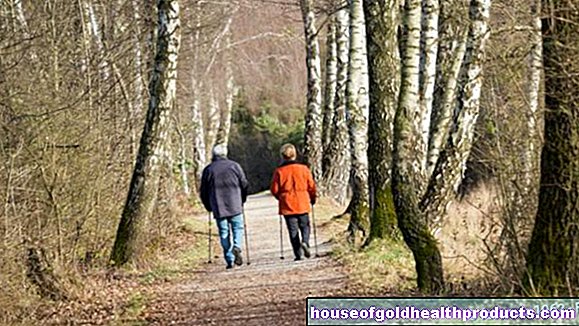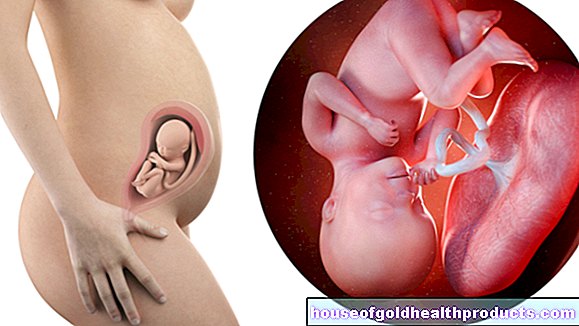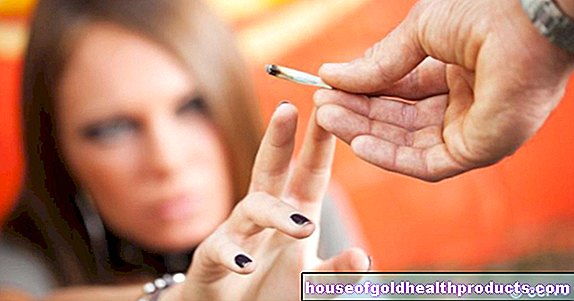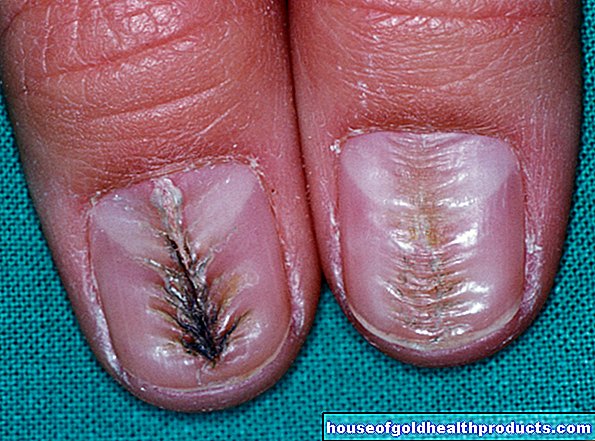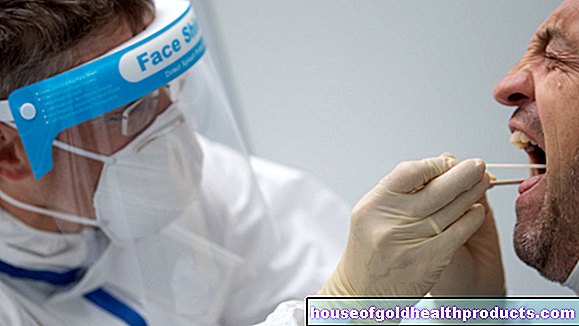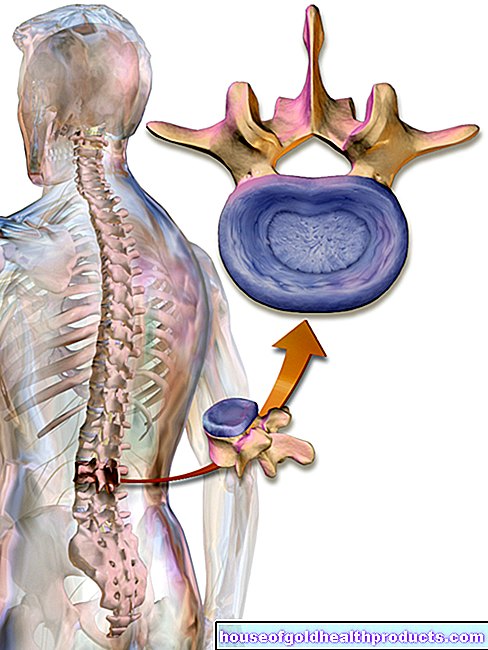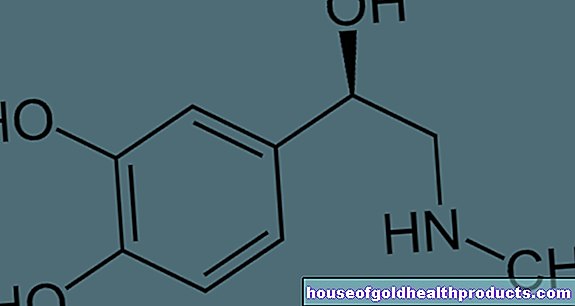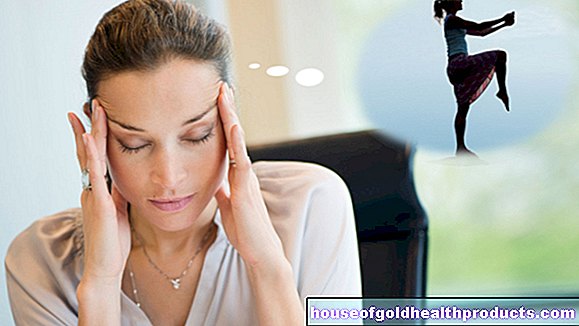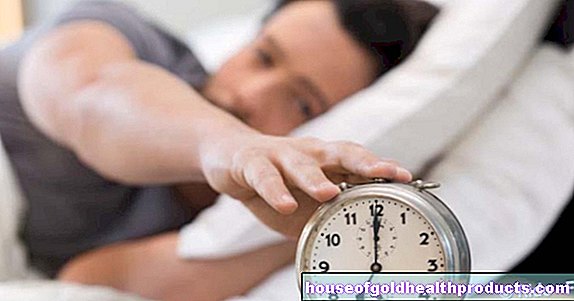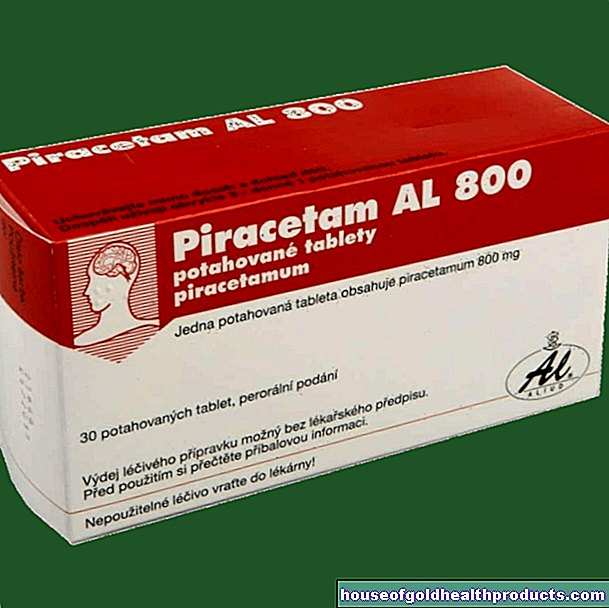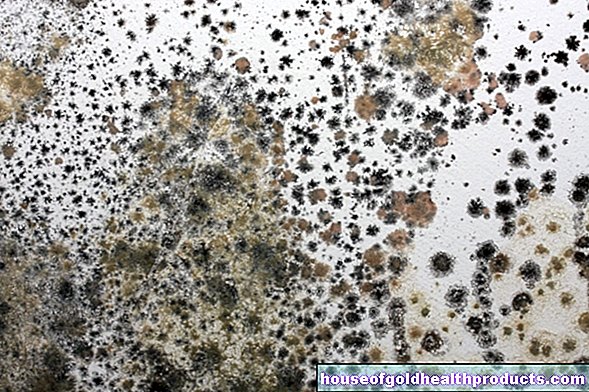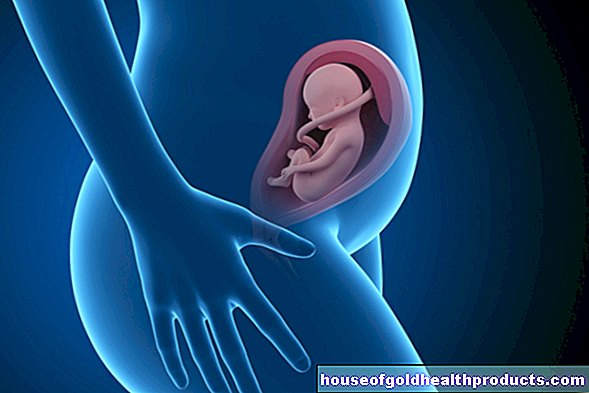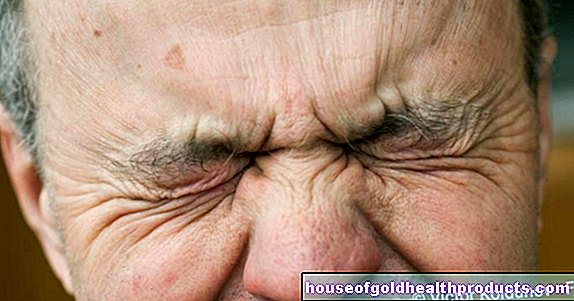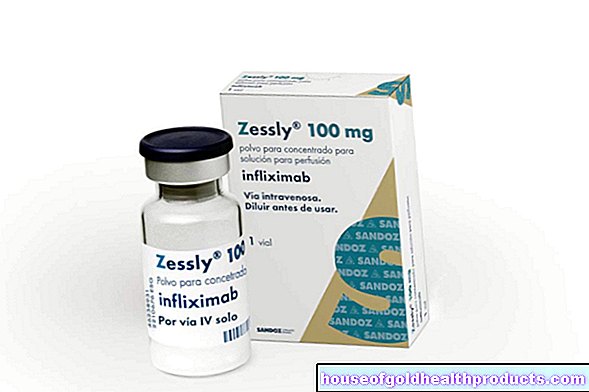Hay fever: therapy
Dr. med. Fabian Sinowatz is a freelancer in the medical editorial team.
More about the experts All content is checked by medical journalists.Medicines are available for hay fever therapy that alleviate the acute symptoms. So-called specific immunotherapy (SIT, "desensitization") is effective in the long term. This form of hay fever treatment is intended to permanently weaken the excessive reaction of the immune system - and thus also the agonizing hay fever symptoms. Some patients also rely on alternative healing methods such as homeopathy for hay fever. Read everything you need to know about hay fever therapy here.
ICD codes for this disease: ICD codes are internationally recognized codes for medical diagnoses. They can be found, for example, in doctor's letters or on certificates of incapacity for work. J30
Hay fever therapy: symptomatic treatment
The annoying symptoms of hay fever can in most cases be effectively relieved with the help of medication. The preparations used target the inflammatory messenger substances histamine and leukotrienes, which the mast cells release as part of the allergic reaction and which trigger the hay fever symptoms: hay fever drugs block the effect of the inflammatory messengers or their release from the mast cells.
The following drugs are used in symptomatic hay fever therapy:
Antihistamines
Antihistamines block the docking points (receptors) of the inflammatory messenger substance histamine so that it can no longer develop its effect. The drugs work very quickly, usually after about an hour. That is why they are suitable for relieving acute hay fever symptoms.
Antihistamines in the form of nasal sprays or eye drops can be used for local hay fever therapy. They are also available as tablets so that they work throughout the body after ingestion. Antihistamines are also available from pharmacies without a prescription.
In the past, antihistamines often made you tired, which was very dangerous, especially in traffic. The so-called "new antihistamines" hardly have this side effect anymore. However, to be on the safe side, doctors recommend taking the antihistamines in the evening before going to bed. Their effect usually lasts for around 24 hours.
Decongestant nasal sprays and nasal rinses
Decongestant nasal sprays provide quick relief from hay fever when the nose is swollen shut. However, they should be used for a maximum of one week.Otherwise, there is a risk that the nasal mucous membranes will dry out, which can worsen the allergic reactions. In addition, decongestant preparations can cause inflammation themselves (medication-related rhinitis, rhinitis medicamentosa).
Nasal rinses are also part of the symptomatic hay fever therapy: They clean the nasal mucous membrane from the pollen. During the day, nasal sprays with saline solution are very useful. However, it is much more effective to rinse the nose with a nasal douche, which is available in drugstores and pharmacies. The allergic complaints can often be significantly alleviated with it.
In order to care for the irritated nasal (mucous) skin, the application of an ointment containing dexpanthenol is recommended.
cortisone
Cortisone is an endogenous hormone that performs numerous functions in the body. Its strong anti-inflammatory effect is also used in hay fever therapy: Substances similar to cortisone (glucocorticoids) are used - due to their strong effectiveness and potential side effects, however, usually only for severe hay fever.
The glucocorticoids are usually applied locally (as nasal sprays), less often systemically (as tablets). With the locally acting cortisone preparations (such as beclometasone nasal spray), hardly any side effects are to be expected.
Mast cell stabilizers (Cromone)
The so-called cromones (such as cromoglizinic acid, nedocromil) “stabilize” the mast cells so that they no longer release inflammatory messengers. However, mast cell stabilizers do not work immediately and do not alleviate any allergic reaction that has already occurred. Rather, those affected should take them about a week before the expected pollen count. Due to the relatively short duration of action, Cromone must also be used several times a day.
Cromone is available in different preparation forms (nasal spray, eye drops, metered aerosol, capsules for ingestion). They only have a local effect - this also applies to the cromoglizic acid, which is available in capsule form. This only takes effect on the mucous membrane in the intestine, but is not absorbed into the body.
The anti-allergic effect of the mast cell stabilizers is not always sufficient to prevent the symptoms of hay fever. The hay fever therapy is then supplemented with antihistamines.
Leukotriene Receptor Antagonists
Leukotriene receptor antagonists block the action of leukotrienes - those inflammatory messengers that are released by mast cells and are involved in the development of hay fever symptoms. are mainly used for allergic asthma, but are also suitable for hay fever therapy. They require a prescription and are available as tablets or chewable tablets.
Hay fever therapy: Specific immunotherapy (SIT, "desensitization")
Specific immunotherapy (SIT) is currently the only option of hay fever treatment that alleviates the mechanism that causes the symptoms - the excessive immune reaction. Doctors therefore also speak of causal (causal) hay fever therapy. The procedure itself, the specific immunotherapy, is also called hay fever desensitization, hay fever desensitization or hay fever vaccination, because the immune system gradually gets used to the actually harmless allergens (pollen) so that it ultimately reacts less “sensitively” to them.
The hay fever therapy by means of desensitization can greatly reduce the symptoms of pollen allergy in the majority of those treated, so that either no antiallergic drugs are required at all or at least significantly less often. Specific immunotherapy can be used not only for hay fever, but also, for example, for allergies to pets or insect bites. However, their use as part of hay fever therapy is particularly useful for three reasons:
- The effect of desensitization is very good, especially with hay fever, as several large scientific studies have shown.
- In the case of hay fever, the allergy-causing substance is difficult to avoid (allergy avoidance), as the pollen often flies through the air for hundreds of kilometers and those affected can hardly protect themselves from it. Desensitization can therefore enormously increase the quality of life of allergy sufferers.
- It can be assumed that hay fever can turn into allergic asthma after a while. This so-called floor change can be avoided through hay fever desensitization.
Hay fever desensitization: how does it work?
The principle of hay fever desensitization consists in introducing the allergenic substance (allergen) into the body in increasing doses so that the immune system gets used to it and no longer fights it. How exactly this habituation occurs has not yet been clarified with certainty. However, the success of desensitization in hay fever is undisputed.
In principle, the attending physician can inject the allergen under the skin (subcutaneous immunotherapy = SCIT) or give it in the form of tablets or drops under the patient's tongue (sublingual immunotherapy = SLIT). The SCIT is considered to be more effective, but also harbors a greater risk potential in terms of possible undesirable side effects. If SCIT is not possible for various reasons or if the patient wishes it, SLIT is used. Both methods have been shown to be effective for hay fever therapy.
Hay fever desensitization: who does it?
Hay fever desensitization is carried out by specially trained doctors. Mostly these are dermatologists, ear, nose and throat doctors (ENT) or internists specializing in pulmonary medicine. The treatment is usually carried out on an outpatient basis in the practice. In the case of a particularly strong allergy or for short-term treatment (see below), however, an inpatient stay may be necessary. Since specific immunotherapy can very rarely lead to life-threatening allergic reactions (anaphylactic reactions), the doctor must have the appropriate knowledge and medication to treat such an emergency.
Hay fever desensitization: when and how long is it done?
When exactly you start the desensitization depends on the type of pollen to which the patient to be treated is allergic. The different plants release their pollen at different times of the year, which the doctor must take into account with this form of hay fever therapy.
Normally, hay fever desensitization begins a few months before the start of the "personal" allergen season (= preseasonal) and therefore usually in autumn. It is less common all year round (= perennial).
In the weeks before the "personal" allergen season, the doctor usually administers the allergens to the patient once a week in increasing doses (increasing doses) up to a maximum dose. During the actual hay fever season, he only gives the allergen about once a month (maintenance dose). Overall, the recommended duration of this hay fever therapy is (at least) three years.
Hay fever desensitization: who is it for?
Desensitization as hay fever therapy is in principle possible at any age. In children, however, it is used at the earliest from the age of three, usually from the age of five or six. One of the reasons for this is that there is only limited systematic data for younger children and that anaphylactic reactions that can occur as a result of the therapy are much more difficult to detect.
Basically, hay fever desensitization is very effective in childhood. However, some people do not develop hay fever until they are older. There is no strict upper age limit for hay fever desensitization. A good general physical condition is important. If in doubt, your doctor will tell you whether or not specific immunotherapy is possible in your case.
Hay fever desensitization: who is it not for?
Hay fever desensitization is not advisable in those cases where the potential risks of the treatment outweigh the expected benefits. These cases include:
- during pregnancy
- in severe diseases of the cardiovascular system
- in severe cancer
- if you have severe diseases of the immune system (autoimmune diseases or acquired immune disorders from medication or diseases such as AIDS)
- with very pronounced asthma
- if you have to take so-called 'beta blockers' to treat another disease
With the exception of pregnancy, hay fever desensitization can still be carried out under certain circumstances in the other cases mentioned. The decisive factor here is an individual risk-benefit assessment by the doctor.
Desensitization for hay fever: how exactly does it work?
Before desensitization is even considered in the case of hay fever, it must be ensured that the symptoms are really allergic and the pollen that triggers them. The doctor uses a prick test (or, if necessary, a patch test / provocation test) to determine which pollen the patient is allergic to.
Before desensitization begins, there is an informative discussion: The doctor informs the patient about the process as well as the possible risks and side effects of the causal hay fever therapy. Even if desensitization is a low-risk procedure, in very rare cases an allergic overreaction (anaphylactic reaction) can occur.
During the consultation, the doctor will also ask the patient about their medical history (anamnesis) so that they can assess whether desensitization to hay fever therapy is safe in a specific case. After the interview, the patient must sign a form to confirm that the doctor has explained the treatment and its possible side effects.
Now the doctor can inject the allergen under the skin (subcutaneous immunotherapy = SCIT) or give it as a tablet or drops under the tongue (sublingual immunotherapy = SLIT). Both procedures take three years.
Subcutaneous Immunotherapy (SCIT)
In SCIT, the doctor uses a syringe with a very fine needle (26G needle). After disinfecting the skin area beforehand, he injects the allergen into a fold of skin on the back of the upper arm. The puncture only hurts for a short time; during the injection the patient feels at most a slight feeling of pressure.
For safety reasons, the patient must remain in the practice for at least 30 minutes after the injection in the event of an allergic overreaction. Local redness and swelling at the injection site are normal. However, if you feel noticeably uncomfortable, you should inform the doctor or staff immediately.
After the 30 minutes, the doctor will check the puncture site again before the patient is allowed to go home. These injections are usually given about once a week for several months. The total number of injections required depends on the product used.
Sublingual Immunotherapy (SLIT)
With SLIT, the doctor places the allergen under the patient's tongue in the form of drops or tablets. It should stay there for two to three minutes if possible, that is, the patient should not swallow for that long. After that, he shouldn't drink anything for at least five minutes. The first application should be done under the supervision of the doctor. The patient can then carry out the SLIT himself.
The patient should report any intolerance reactions to the attending physician immediately! In the event of illness (especially if you have a fever), the intake should be interrupted. In addition, the patient (and the doctor) should generally follow the instructions of the preparation manufacturer.
Desensitization for hay fever: what should be considered afterwards?
In the hours before hay fever desensitization and for the rest of the day after allergen administration, patients should refrain from alcohol and physically strenuous activities (e.g. sport, sauna, etc.), as this could trigger or worsen allergic reactions.
If someone wants or has to have a vaccination during hay fever treatment, the vaccination date should not be in the increase phase (weekly allergen administration for SCIT), but in the maintenance phase (approximately monthly allergen administration). There should be at least one week between the vaccination and the desensitization session. Immediately necessary vaccinations (e.g. tetanus vaccination after injury) can be given at any time.
Desensitization for hay fever: short-term therapy
For hay fever therapy, the specific immunotherapy can also be carried out in a very short period of time. However, the long-term effect of this short-term therapy cannot yet be conclusively assessed, as it is a relatively new procedure.
The dose build-up in short-term therapy takes place very quickly with around four to eight injections before the pollen season. Variants in which several injections take place in one day are also possible. These so-called RUSH or Ultra-RUSH procedures are not yet the standard and are not offered by all doctors or clinics.
Alternative therapy for hay fever: homeopathy
Many people see homeopathy as an effective alternative or supplement to classic hay fever therapy. From a scientific point of view, the effectiveness of homeopathy for hay fever has so far been rather controversial. There have been numerous studies on the effectiveness of homeopathy for hay fever in the past few decades. In most cases, however, these did not contain any objective target values, but rather the test persons only stated their subjective perception of the effectiveness of homeopathy - and this is hardly verifiable and depends on a wide variety of influencing factors.
A study from India therefore took a different approach (Gosh et al., 2013): It not only showed that homeopathy can actually alleviate hay fever, but above all it was able to discover verifiable changes in laboratory values as a result of the homeopathic treatment. In this comparatively small study with 34 subjects, the concentration of the so-called Ig-E antibodies and eosinophilic granulocytes (subgroup of white blood cells) in the blood was measured.
A year-long hay fever therapy with various homeopathic drugs resulted in a statistically significant decrease in these values, which are usually higher in allergic diseases such as hay fever. Among other things, they were used Natrum muriaticum, Histaminum, Psorinum, Lachesis muta, Allium cepa and Euphrasia officinalis.
The homeopathic treatment not only changed the laboratory values, the symptoms also improved significantly. In order to further increase the acceptance of homeopathy for hay fever and to prove its effectiveness, further scientific studies with a larger number of test persons are necessary.
Organotropic Homeopathy
Some doctors see hay fever therapy as a suitable field of application for so-called organotropic homeopathy (indication-based homeopathy).
This direction of homeopathy largely manages without the otherwise very time-consuming medical history (anamnesis). Instead, the patient is given homeopathic medication, which experience has shown to generally help with a certain disease. On the one hand, the treatment is therefore much less tailored to the individual patient. On the other hand, this direction of homeopathy enables rapid treatment. This also makes self-treatment easier. In principle, however, you should not use homeopathy for hay fever without the advice of a doctor or homeopath.
Homeopathy for hay fever: Commonly used preparations
|
Homeopathic medicine |
operation area |
|
Galphimia glauca |
For watery, itchy eyes and severe sneezing attacks. Can also be taken preventively - starting six to eight weeks before the pollen season. |
|
Allium cepa (kitchen onion) |
Discomfort, especially in the nose: Burning, watery runny nose |
|
Euphrasia (eyebright) |
Discomfort especially in the eyes: Burning, watery eyes. |
|
Wyethia helenoides |
Itching in the throat or deep in the throat |
|
Arundo mauritanica (water pipe) |
Itching in the ears |
These homeopathic remedies are usually used in the potentiation D6 or D12. Patients should take five globules about three to five times a day. If the symptoms are very severe, the person affected can take five globules every hour for six to ten hours. From the second day onwards, he reduces the dosage back to the usual level (five globules three to five times a day).
These details are only a rough guide for homeopathic hay fever therapy and in no way replace advice from a doctor or homeopath.
Tags: Diagnosis medicinal herbal home remedies fitness